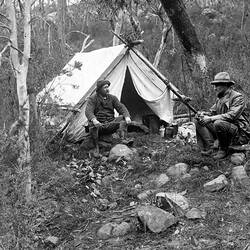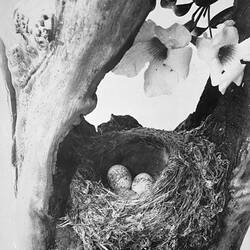SCARLET-BREASTED ROBIN (Petroca Leggii, Sharpe - 165)
Geographical Distribution - South Queensland, New South Wales, Victoria, South Australia and Tasmania.
Nest - Cup-shaped, neat and beautiful; constructed on soft bark, covered with pieces of outer bark stuck on by spiders' web so as to resemble the limb on which the nest is placed; lined inside with fine inner bark and finished warmly with fur, sometimes a feather or two in addition. Usually situated in the strong, upright, forked branch of a sapling or small tree in a retired locality in open forest. Occasionally the nest is placed in the hollow part of a tree trunk. Dimensions over all, 3 inches by 3 inches in depth; egg cavity, 1 ½ inches across by 1 3/8 inches deep.
Eggs - Clutch, three to four; roundish in shape, but more pointed at one end; texture of shell fine; surface slightly glossy; colour, light greenish-white, much spotted and speckled, especially round the upper quarter, with umber and dull-grey. Dimensions in inches of a proper clutch: (1) .72 x .58, (2) .72 x .58, (3) .71 x .56. (Plate 8).
Observations - This lovely-feathered forest gem is a great favourite with collectors, and is fairly dis-tributed from South Queensland round to South Australia, its place being taken in Western Australia by an allied species, P. cambelli (Sharpe). The dress off the Scarlet-breasted Robin is - upper surface, including throat and head, black, excepting conspicuous patch of white on forehead, and longitudinal white bands on the wings; breast and upper part of abdomen scarlet, rest of under surface white. Length, 4½ inches; wing, 2¼ inches; tail, 2 inches; bill, 5/8 inch. The plumage of the female is brownish, the breast sometimes being tinged with red. One never forgets one's enthusiasm over the finding of the first Robin's nest. I well recollect my first find, which happened to be a nest of the Scarlet-breasted species, that I discovered, with the hen bird sitting, in the forked branch of a 'manna-gum' (Eucalyptus), that grew in a secluded part of a bush paddock not far from what is now Murrumbeena, Victoria.
Mr. A. J. North writes: - 'On the partially cleared land in the dense forest of South Gippsland (Victoria) I have often found the nest of this species by seeing the bird fly into one of the huge, blackened, hollow trunks of eucalyptus, that has been destroyed by fire. The nest is placed about six or seven feet from the ground, on a projecting piece of roughened and charred wood; it is composed of strips of bark, grasses and mosses, securely held together by cob-webs, and lined with hair, fur, feathers, &c., and sometimes with the soft downy fibre of the inner bark of the tree-fern (Dicksonia antarctica).'
The Scarlet Robin's nest, for appearance and situation, is always a picture, but one remarkably so was first brought under my notice by my friend, Mr. J. Gabriel. It was in a cleft in a small dead musk-tree (Olearia) stem. A length of about fifteen inches, containing the nest, was sawn off and made a most beautiful photograph (see illustration). The interesting exhibit was afterwards presented to the Australian Museum, Sydney, where it has been set up with the instructive and artistic 'bird groups'.
I have found the egg of the Narrow-billed Bronze Cuckoo (C. basalis) in the nest of the Scarlet-breasted Robin.
Gould states this Robin usually rears two or three broods in a year, the period of nidification commenc-ing in August, and ending in February; but we may infer that the chief breeding months are from October to December.
References
Transcribed - Archibald James Campbell. 'Nests and Eggs of Australian Birds, including the Geographical Distribution of the Species and Popular Observations Thereon', Pawson & Brailsford, Sheffield, England, 1900, pp. 134-135.
More Information
-
Keywords
-
Authors
-
Contributors
-
Article types


